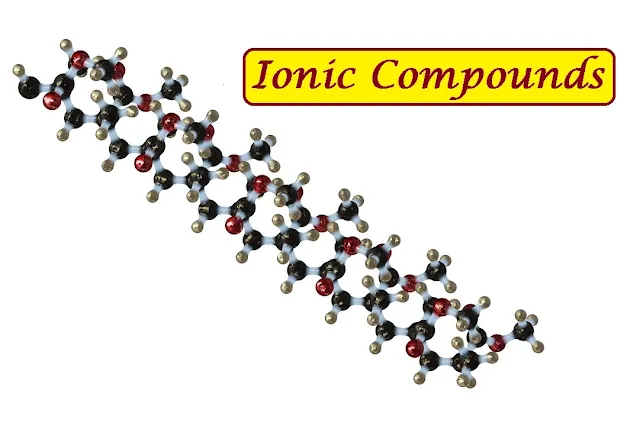Ionic Compound is made up of carbon with hydrogen, oxygen, nitrogen, etc. The melting and boiling point of the carbon compounds are lower than 300-degree celsius. Because the intermolecular attractive force is weak in carbon compounds.
 |
| Ionic Carbon Compound |
Why are ionic compounds electrically neutral?
- The compounds formed from two units namely cation and anion are called ionic compounds.
- They have any electrostatic force of attraction called an ionic bond.
- The number of cations and anions in a compound and the magnitude of the electric charge on them is such that the positive and negative charges balance with each other. Therefore an ionic compound is electrically natural.
Why are ionic compounds crystalline in nature?
- The surface of all the particles of a crystalline substance has a definite shape and is smooth and shiny.
- The regular arrangement of ions in aqueous solid ionic compounds is responsible for their crystalline nature.
Why are the melting points of ionic compounds high?
- The ionic compounds are hard and brittle.
- The electrostatic attraction in the neighboring ions with opposite charges is very strong. Therefore, the melting points of ionic compounds are high.
Why are ionic compounds water-soluble?
- The water molecules orient in a particular manner around the ions separated by the dissociation process.
- As a result of this, a new force of attraction is established between the ion and the surrounding water molecules.
- Replacing the original intermolecular attraction and the aqueous solution of ionic compounds are formed.
What are the various physical properties of metals?
- Metals are generally found in nature in solid-state.
- Metals possess a cluster.
- It has ductility and malleability.
- It is a good conductor of heat and electricity.
- Metals have a liquid state also.
- Metals have high melting and boiling points.
- It has a Sonority.
What are the various physical properties of nonmetals?
- Non- Metals exist in the solid and gaseous states.
- Non-metals do not possess luster.
- Non-metals are not hard.
- Non-metals have low melting and boiling points.
- Non-metals are bad conductors of electricity and heat.
Why are metals called electropositive elements?
- Metals are reactive.
- It losses electron easily in the process of the chemical reaction and become positively charged ions.
- that is why metals are called electropositive elements.
Why are highly reactive metals combined with oxygen?
- Highly reactive metals as sodium, potassium, magnesium, etc. combine with oxygen on heating in air and metal oxide is formed. Sodium and potassium are very highly reactive metals that combine with oxygen in the air even at room temperature and forms sodium oxide.
4 Na + O2 ----> 2na2 O
Na2 O + H2O ------> 2NaOH
MgO + H2O---->Mg(OH)2
Why is sodium kept in kerosene to prevent accidents in the laboratory?
- Sodium is a highly reactive metal that combines with oxygen on exposure to air readily catches fire.
- It also highly reacts with water to form a locally and catches fire and exploding.
4 n A + O2 -----> 2Na2 O
Na2 O + H2O----->2NaOH
- Therefore to prevent accidents in the laboratory sodium is kept in kerosene.
Why do moderately reactive metals reactions call out in the form of bubbles?
2 K + 2 H2O ----> 2 KOH + H2
Calcium reacts with water slowly and less vigorously. Hydrogen gas released in this reaction callouts in the surface of the metal in the form of bubbles and the metal floats on water.
Define Aqua regia.
- Aqua regia is a highly corrosive and fuming liquid.
- It is one of the few reagents which can dissolve noble metals like gold and platinum.
- Aqua regia is freshly prepared by mixing concentrated hydrochloric acid and concentrated nitric acid in the ratio of 3: 1.
Why do Noble gases not take part in chemical reactions?
- Metals do chemical reactions by losing electrons while non-metals do this by gaining electrons.
- The outermost shell of noble gases being completed and therefore, they are chemically inert and Noble Gases do not take part in a chemical reaction.
Why are non-metals also called electronegative elements?
- Non-metals are a collection of elements having less similarity in physical and chemical properties.
- Non-metals are also called electronegative elements as they form negatively charged ions by accepting electrons. Some examples of chemical reactions of nonmetals are as follows:
C + O2----> CO2
2c + O2 ------>2CO
S + O2 ------->SO2
I hope this article is useful to you, then you have to follow us by email, and follow us on social media. For further reading, you click here.
